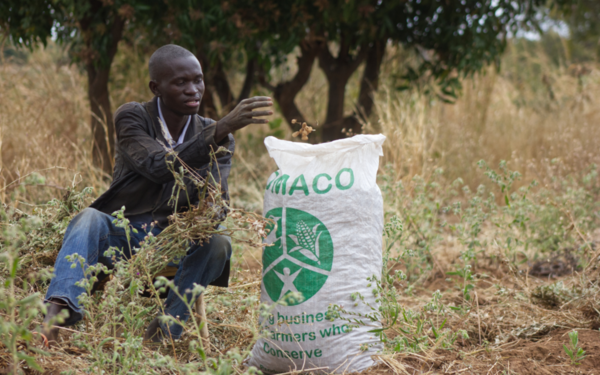- Share this article
- Subscribe to our newsletter
From lost products to safe food – Innovations from Zambia
Food losses occurring at early stages of the food value chain are a big problem, not only but especially in Sub-Saharan Africa. Most of these losses are caused by inadequate harvesting and handling techniques as well as insufficient storage and cooling facilities. This can have an impact both on quantity and quality of the harvested produce.
Mould infections caused by high moisture content, for instance, pose a serious threat for the safe consumption of groundnuts. Aflatoxin, a poison created in fungal growth, is one of the most widespread quality challenges in groundnut-producing countries. Chronic exposure to aflatoxins, even at low doses, leads to malnutrition, child stunting and damage to the liver as well as suppression of the immune system.
Policies at national level aim at controlling aflatoxin contamination, but samples from the ground still reveal higher contamination levels surpassing the threshold fourfold. Economically, aflatoxins reduce the quantities of marketable and edible groundnuts. As aflatoxins cannot be destroyed by cooking, the prevention of contamination is of highest importance.
Causes of post-harvest losses of groundnuts can be found along all steps of the value chain: from poor practices in the field, improper drying, and storage and transportation after the harvest to processing of raw produce into value-added products. It is critical to ensure that moisture content in groundnuts remains low to prevent mould infections.
Proper drying is thus the first step of the post-harvest processing of this crop. For farmers it is common to dry the groundnuts on exposed ground, floors, and rooftops – with no protection against rain or moisture. Poor storage facilities and insufficient packaging can further increase the risk of fungal growth, as well as pests. Finally, improper and untimely shelling can also damage the nuts and provide a favourable environment for the growth of mould.
Combating post-harvest losses through better aflatoxin management
In collaboration with the social enterprise Community Markets for Conservation COMACO, the Green Innovation Centres for the Agriculture and Food Sector Project in Zambia, being part of the ONE WORLD – No Hunger Initiative of Germany’s Federal Ministry for Economic Cooperation and Development (BMZ), is aiming at combatting post-harvest losses along the value chain. For example, training modules for post-harvest management are developed and integrated into the curricula of farmer field schools and are advertised on interactive radio shows. By introducing and demonstrating innovative techniques and methods in post-harvest processes, producers are trained, and at the same time, they are made aware of how to avoid losses.
Since 2015, more than 130,000 smallholders farmers in the eastern province of Zambia have been trained on aflatoxin management and more than half (52%) have already adopted these practices. Further, more than 1,200,000 persons are continuously reached through weekly radio shows. In the local processing plant of COMACO, unshelled peanuts are checked for colour and size in several steps to sort out mouldy fruit while keeping losses as low as possible. This allows local and international consumers to buy and eat safe, high-quality products like peanut butter.
Another success is that in 2020, COMACO exported four tons of certified organic peanut butter to the USA for the first time.
Resource efficient agricultural production of safe food is an essential part of our food system. The reduction of food loss and waste is therefore an important task. Post-harvest losses can be observed everywhere. However, the drivers behind these losses are often obscured and lie in completely different value chain steps.
One good way to take action to reduce post-harvest losses is therefore to identify loss hot spots in a selected value chain and determine the underlying drivers together with all value chain actors and other experts. To facilitate this process, GIZ developed the Rapid Loss Appraisal Tool (RLAT). As an interactive and participatory methodology, RLAT helps to create a common understanding of food loss hot spots and to develop solutions along way.
Matthias Berthold, Sebastian Köcke, Natasha Mwila and Claudia Witkowski, Deutsche Gesellschaft für Internationale Zusammenarbeit (GIZ), Bonn/Eschborn, Germany.
This article first appeared at weltohnehunger.org and is part of a media cooperation between and Rural 21 and One World - No Hunger.
More information:
User Guide
Toolbox





Add a comment
Comments :
It's a very good integrated approach in tackling post harvest loss and mitigating public health related issues. Critically, political will is very vital for all those factors in the sub sector value chain to be successfull.
Take a look at my country and Kenya, metric tons of maize from Uganda were rejected to enter in kenya because of aflotoxin issues.
I am happy that groundnut butter as a final good is being exported after passing through series of international standards.
I would appreciate if one time we share some best practices so that my community could adopt ro become resilience.